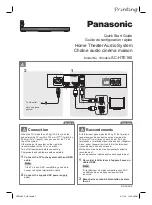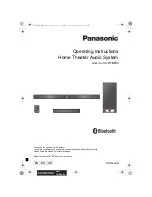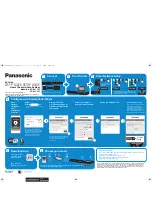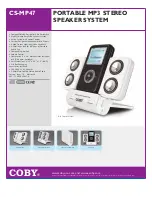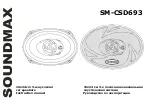
connection
SA mantra- & aura-series are quality speakers
which can be used for any Hi-fi stereo or
surround system.
The speakers does not need a particularly
strong electrical current from the amplifier, e.g.
2 x 50 W will often run a set of SA mantra- or
SA aura-series speaker, with a good result,
provided the quality of the amplifier and
connected equipment is sufficiently high.
!
important.
The amplifier must be turned off before the
connection is made
using the sand chamber
SA mantra/aura 50 and 70
When you have found the ideal position for your
new speakers, it is a good idea to mark the
position precisely so it is easier to find it again. You
may want to use strips of tape on the floor.
1. Turn off the amplifier/the receiver and remove
the cables from the
speakers.
2. Turn the speakers upside-
down carefully. Use a soft
underlay to avoid scratching
the finish. Take care not to
touch the drive units!
3. Remove the plastic stopper.
You may wish to use a pair
of flat-nose pliers to protect
your fingers.
4. Fill with dried sand. Use a
litre measure, so you can
pour the same volume of
sand into both speakers.
The SA mantra / aura 70 can
hold 3,5 Litres, and the SA
mantra 50 / aura 50 can hold
2,5 Litre of sand. We
recommend that you use
around 2 Litre of sand. You
might want to experiment to
find your own preferred
damping level.
!
Important
Never use damp sand or the
likes. Moisture will seep into
the cabinet and damage it.
5. Secure the plastic stopper.
6. Carefully raise the speakers.
7. Place the speakers in the
marked positions.
8. Connect the speaker cables
3
2
3
4
5
6
A
A
B
C
D
example of set up
The sound from speakers depends very much on
the room and on the way they are set up. You may
wish to ask your dealer for advice on how to get
the best sound with SA loudspeakers in your
home.
Here is some general advice about experimenting
with the set up.
A
the distance between the rear of the
speakers and the wall behind them
Start with a distance of 30 cm for SA mantra/
aura 50 / 70 or 10 cm for SA mantra 10, aura 1
& 10. The distance should be identical for both
speakers. Try the speakers out with music you
know and find out what distance gives the best
sound in your home.
Greater distance
= weaker bass, more precise
bass, better precision and bigger sound stage.
Shorter distance
= more and softer bass,
smaller sound stage.
B the distance from the side walls to the
speakers.
Preferably greater than the distance to the
back wall
A short distance to the side walls increases the
amount of bass in the same way as A.
C,D the distance between the speakers and the
listener.
The ideal distance between the speakers is 2.5
– 3 metres. Distances C & D should preferably
be the same.
The speakers should be at an angle of approx.
15°. This means the listener should just be
able to see the two inner sides of the speakers
Right
speaker
Left
speaker
Right speaker
Left speaker
connection – double check
Check that the cables are properly mounted. Make
sure the electrical phase is correctly attached to
the speaker connections. This means that cables
attached to plus (
+
) or minus (
-
) on the amplifier/
receiver must also be attached to plus (
+
) or minus
(
-
) on the speakers.
On SA speakers the positive connection is
indicated by a red socket or a plus (
+
).
Follow the speaker cables to make sure that the
right and left channels (and the centre and rear
channels where appropriate) are attached
correctly.
Please notice:
The better your equipment, the better the
speaker will sound
Good cables improve the sound
Spend time experimenting with the position of
the speakers
The closer the speaker is to a wall, the more
bass. Move them further from the walls for less
bass. A corner will significantly increase the
amount of bass and make the sound
"rumbling" and "massive"
Avoid the use of iron stands underneath
compact loudspeakers. Magnetic interference
on the crossover will alter the sound
Never turn the volume up to a level where the
sound is no longer good
Remove the front grille for the best possible
sound
See
www.system-audio.com
for good advice
and ideas
maintenance
Clean the surface of the speaker with firmly wrung
damp clothes
!
important
Do not use detergent. It may discolour the finish
The fabric front is easily removed by a slight
movement away form the speaker and is best
cleaned by a vacuum cleaner with a brush-head
attached
!
important
Do not use a vacuum cleaner to remove dust from
the speaker elements. Brush it away gently with a
soft brush.





